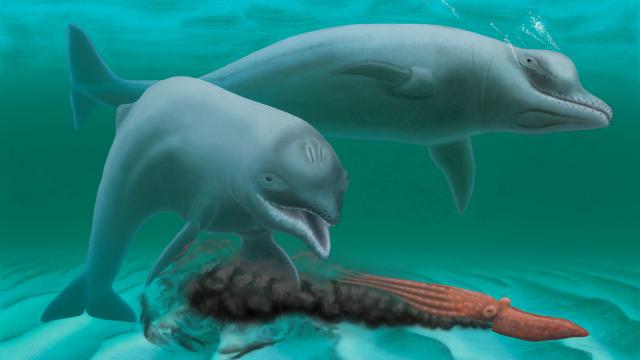Scientists have uncovered the fossilised remains of an unusual species of dolphin that lived 30 million years ago in what is now South Carolina. These extinct aquatic mammals measured just 90cm in length, featured short snouts, and perhaps strangest of all, they had no teeth.
Artist’s depiction of Inermorostrum xenops, an extinct toothless dwarf dolphin species. (Robert W. Boessenecker)
As described today in Proceedings of the Royal Society B, this newly discovered creature represents both a new species and an entirely new genus. Its name, Inermorostrum xenops, means “defenseless snout” — a reference to its toothless constitution. The lead author of the new study, Robert W. Boessenecker from the College of Charleston, says this animal belongs to the Xenorophidae family — an ancient group of echolocating dolphins that represent the earliest evolutionary offshoot from toothed whales. As the discovery of Inermorostrum suggests, an interesting set of evolutionary experiments led this aquatic mammal down a very strange path.
Boessenecker’s analysis was based on the discovery of a single Inermorostrum skull, which was recently found in a limestone outcrop by a diver in South Carolina’s Wando River. Like other Xenorophids, its facial features suggest it had the ability to echolocate, but that’s where the similarities end. Inermorostrum had a tiny body, a snout about three times shorter, and a mouth completely devoid of teeth (other Xenorophids had a complete dental profile, featuring at least 11 teeth in its upper jaw). Clearly, this ancient dolphin had followed a different evolutionary path — but to what end?
Modern dolphins, with their long toothy snouts, are good at catching fish, but as Boessenecker points out, short snouts, which typically appear in toothed whales, are good for suction feeding.
“The smaller the oral opening, the greater the suction — pilot whales, belugas, and porpoises all have similarly short snouts and large, muscular lips,” explained Boessenecker in an email to Gizmodo. “The last feature is perhaps the most critical — toothlessness, or tooth reduction, [as it describes] suction feeding specialists like the narwhal (the tusk is the only tooth, and it is not used for feeding), sperm whales (which lack upper teeth), and beaked whales (which typically only have small tusks, also not used for feeding).”
The combination of a short snout and toothlessness, says Boessenecker, suggests Inermorostrum was not only capable of suction feeding — it was an “obligate” suction feeder, meaning it could only use suction to feed. What’s more, grooves and holes on its snout suggests it had enlarged lips or whiskers, both of which are useful for suction feeders. Based on these features, along with its diminutive body and downward slanting snout, Boessenecker speculates that Inermorostrum was a suction feeding specialist, gobbling up fish, squid and other soft-bodied creatures from the seafloor much like modern walruses.
Interestingly, Inermorostrum appeared just four million years after the emergence of its toothed whale ancestor, which suggests this echolocating species evolved its suction-feeding characteristics rather quickly. But alas, this specialised feeder was not to be. Today, modern dolphins, such as the bottlenose dolphin, feature a snout that’s twice as long as it is wide, allowing it to catch fish and participate in suction feeding. As is so often in the case in biology, it’s best to avoid over-specialisation and not paint oneself into an evolutionary corner.
